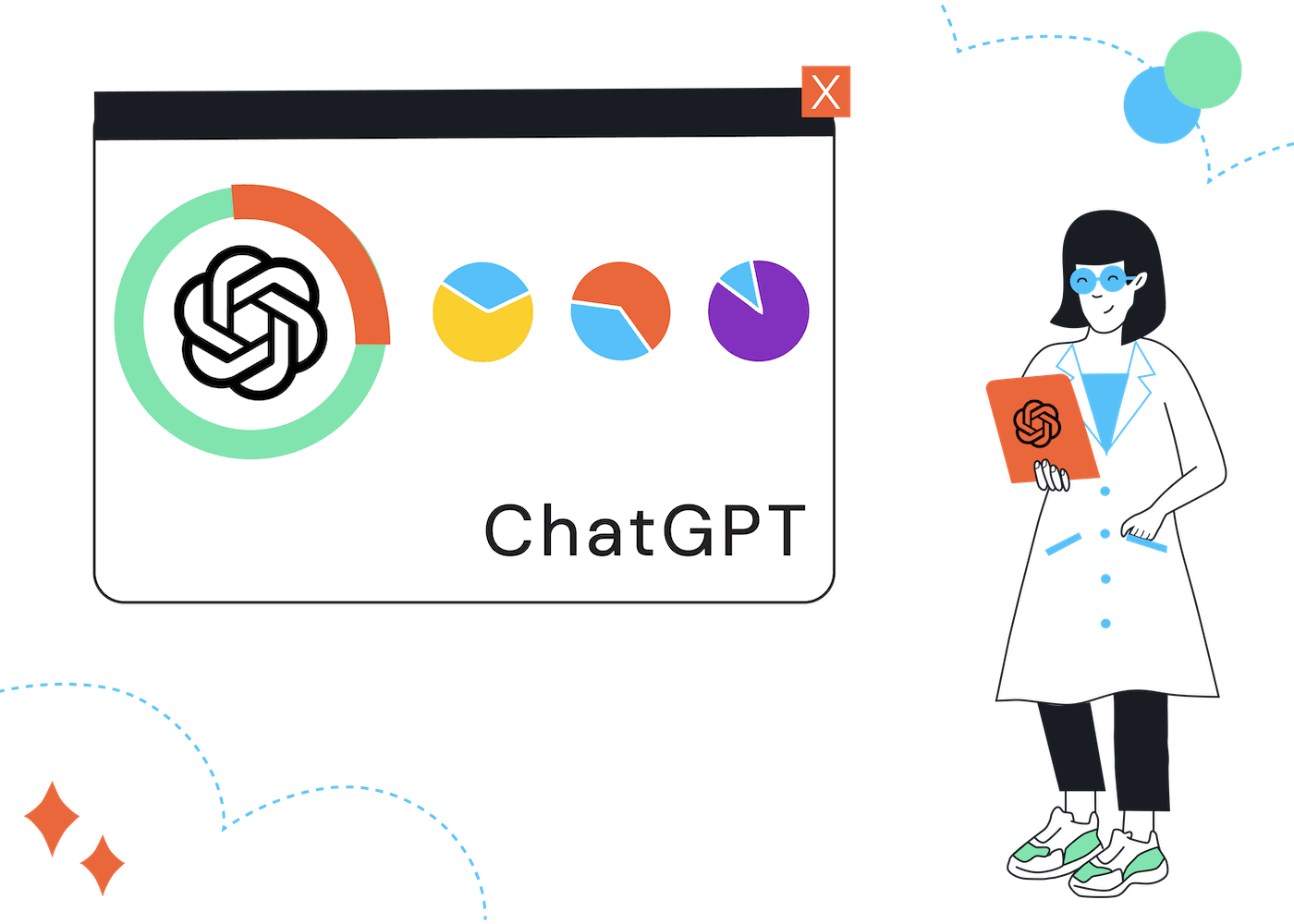Since its launch, ChatGPT has gone viral as a human-like chatbot that responds to users based on what they input.
The tool is able to answer questions and produce responses based on a dataset of an estimated 100 trillion parameters. It has already become a key tool for growing businesses and maximizing efficiency.
We’ve taken a deep dive into some of the most interesting ChatGPT statistics and facts for 2025 from the latest data and reports.
Key Statistics
- ChatGPT gained one million users in its first week after launch.
- The ChatGPT website received an estimated 1.8 billion website visitors in April 2024 (an increase of around 200 million from 1.6 billion in February 2024) with an estimated 100 million active users.
- In May 2024, OpenAI announced ChatGPT-4o which can accept and generate combinations of text, images, audio, and videos.
- The ChatGPT website received an estimated 1.6 billion website visitors in December 2023 (a decrease of around 1 billion from November 2023), with an estimated 100 million active users
- The tool set a record for having the fastest-growing user base in history for a consumer application, gaining 1 million users in just 5 days.
- Some OpenAI executives are predicting a revenue of $5 billion by the end of 2024, a huge jump from the $200 million predicted by the end of 2023.
- ChatGPT contains 570 gigabytes of text data, which is equivalent to roughly 164,129 times the number of words in the entire Lord of the Rings series (including The Hobbit).
- It is estimated that training the model took just 34 days.
- The latest estimates suggest that ChatGPT costs $700,000 per day or $21 million per month to run, with each query costing $0.36.
- The tool costs approximately $100,000 per day or $3 million per month to run on Microsoft’s Azure Cloud, with each word generated costing $0.0003.
- The majority (60.97%) of OpenAI’s site visitors are aged between 18 and 34, and they are 54.11% male and 45.89% female.
- An average of 53% of people can’t tell that ChatGPT content was generated by an AI.
- When GPT-3 launched, it caused AI token cryptocurrency prices to jump by up to 76.7%.
What is ChatGPT?
ChatGPT (Chat Generative Pretrained Transformer) is a chatbot that produces human-like AI-generated content based on the input it is given by a user. It was developed by Open AI and released in November 2022.
How does ChatGPT work?
ChatGPT uses ‘transformer architecture’, a deep learning technique that works through terabytes of data containing billions of words in order to create answers to questions or prompts entered by a user. It is a version of machine learning Natural Language Processing models called Large Language Models (LLMs).
Listen to CEO and Co-Founder Sam Altman talk about the history of OpenAI on this podcast from 2023. At minute 41 he talks about the current challenges of AI. Among other things, he describes that the current GPT-version is mainly trained to sound coherent but not to verify facts, quoting: “[AI chatbots] are very convincing bullshitters”.
When was ChatGPT launched?
The original version, GPT-1 was released on June 11th 2018, with the most recent iteration, GPT-4 Turbo being released in November 2023.
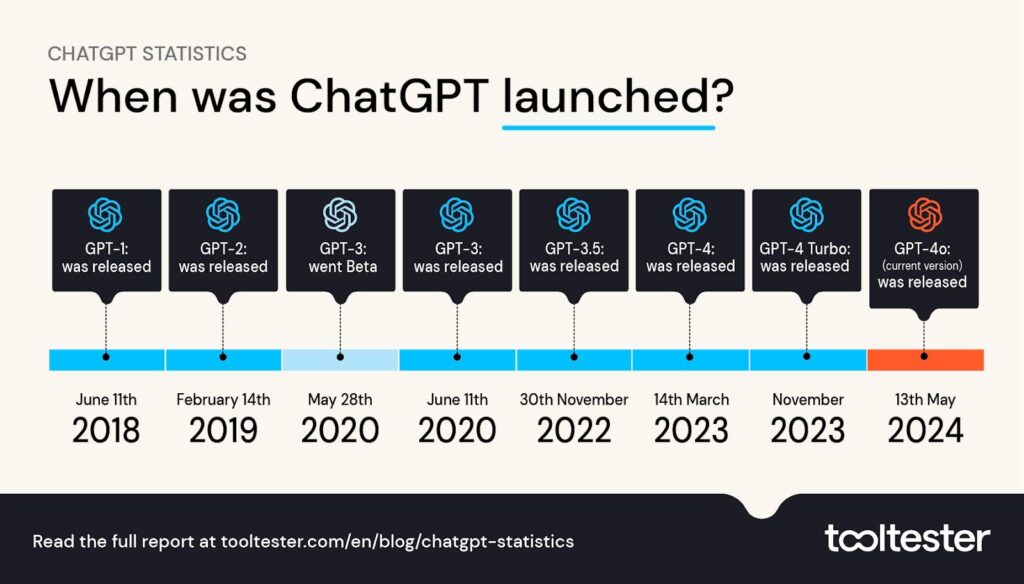
(Sources: OpenAI, Venture Beat)
The first iteration of the tool, GPT-1, was trained using a massive BooksCorpus dataset. This version was able to obtain large amounts of data with diverse sets of text in sequence, and learn a wide range of dependencies.
GPT-2 used a larger dataset with more parameters (1.5 billion compared to 150 million in GPT-1), making it a richer language model.
2020’s GPT-3 contained even more parameters (around 116 times more than GPT-2), and was a stronger and faster version of its predecessors.
ChatGPT-4
Launched in March 2023, ChatGPT-4 is the most recent version of the tool. Since being updated with the GPT-4 language model, ChatGPT can respond using up to 25,000 words (8x more than the previous version) and has the ability to process image inputs as well as text, making it multimodal.
It is estimated that ChatGPT-4 was be trained on 100 trillion parameters, which is roughly equal to the human brain. This suggests that the training data for the latest version could be 571 times larger than the 175 billion parameters used for ChatGPT-3. (Source: Wired, Hix.ai)
OpenAI reports that the newest version can produce 40% more factual responses and is 82% less likely to respond to requests for disallowed content.
ChatGPT: GPT-3.5 vs GPT-4
The key differences between GPT-3.5 and GPT-4 are their capabilities including the amount and type of information they can process. GPT-4 comes in two variants, one being the 8K version which has a context length of approximately 8,000 tokens, and the other being 32K which can process roughly 32,000 tokens.
This means that the latest version of the tool can handle longer documents, create larger pieces of text, and maintain longer conversations without context being lost.
| GPT-3.5 | GPT-4-8K | GPT-4-32K | GPT-4 Turbo | |
|---|---|---|---|---|
| Maximum context length for requests | 4,096 | 8,192 | 32,768 | 128,000 |
| Number of English words | ~3,000 | ~6,000 | ~24,000 | 96,000 (240 pages at 400 words per page) |
| Number of single-spaced pages of English text | 6 | 12 | 50 | 240 |
| Input types | Text | Text and images | Text and images | Text and images |
ChatGPT-4o
In May 2024, OpenAI launched its new iteration of ChatGPT, called GPT-4o (the “o” meaning “omni”). In the announcement, the company explained that this new version is “a step towards a much more natural human-computer interaction”. The tool can now accept any combination of text, images, audio, and video to generate any mix of text, audio, and image outputs.
ChatGPT-5
OpenAI is continuing to develop ChatGPT, and GPT-5 was reportedly due to finish training in December 2023. Sam Altman reported that GPT-5 would require more data to train on, and that the plan was to use publicly available datasets from the internet. However, there is no launch date currently set for GPT-5.
How many users does ChatGPT have?
ChatGPT gained one million users in its first week after launch. This set a record for the fastest-growing user base for a consumer application in history.
The ChatGPT website received an estimated 1.8 billion visits in April 2024 (a 12.5% increase on Febuary’s 1.6 billion visitors). The exact number of active users is currently unknown. Our best guess would put it at around 100 million.
ChatGPT’s users are located around the world, with the largest proportion (an estimated 15.3%) being from the U.S. The second-largest proportion of users is thought to be from India, with around 7.06% of users living here.
| Country | Percentage of ChatGPT users |
|---|---|
| United States | 15.3% |
| India | 7.06% |
| Philippines | 3.68% |
| Colombia | 3.66% |
| Peru | 2.92% |
| Other | 67.37% |
(Source: SimilarWeb)
What countries does ChatGPT support?
ChatGPT is currently supported in 163 countries according to OpenAI.
It is available in all countries except the following:
- China
- Russia
- Ukraine
- Belarus
- Venezuela
- Afghanistan
- Iran
ChatGPT’s use is now supported in Ukraine but with certain exceptions.
What languages does ChatGPT support?
ChatGPT works mainly in the English language, however, SEO.ai reports it does understand 95 other languages spoken around the world including French, Spanish, German, and Chinese.
The model was primarily written in the Python computer programming language. It is capable of understanding a number of programming languages, including:
- Python
- JavaScript
- C++
- C#
- Java
- Ruby
- PHP
- Go
- Swift
- TypeScript
- SQL
- Shell
ChatGPT’s growth compared to other platforms
Compared to other popular platforms, ChatGPT has grown incredibly fast. It reached a million users in just five days, 70 days faster than Instagram, the second fastest platform to reach 1 million users at the time ChatGPT was launched.
Since then, Meta’s Threads beat ChatGPT’s record by reaching 1 million users in just one hour when it was launched on the 5th of July 2023. Threads then became the fastest app to reach 100 million users, hitting the milestone in just 5 days. (Sources: Statista, Visual Capitalist)
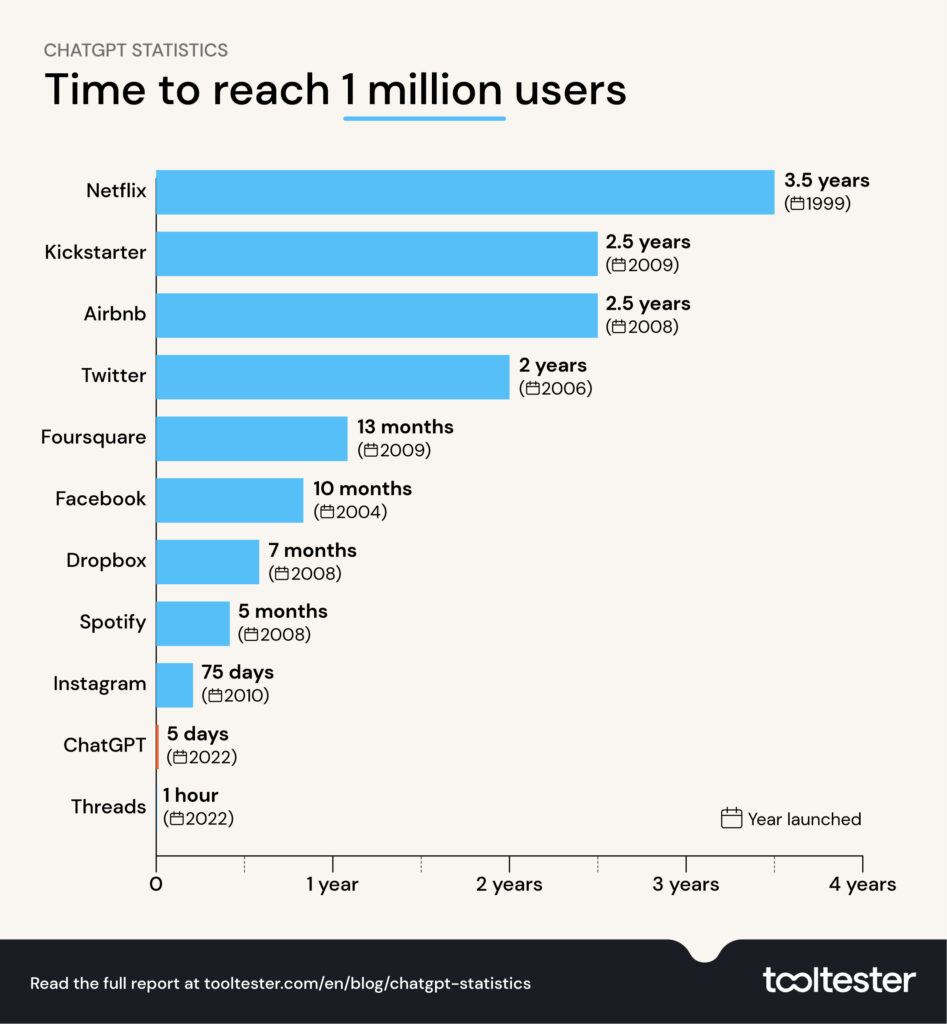
(Source: Statista)
ChatGPT’s infrastructure
ChatGPT runs on Graphics Processing Units (GPU) which is a specialized processor with dedicated memory which is designed to increase the speed of graphics rendering. This kind of processor is made up of lots of smaller, more specialized cores.
According to Tom Goldstein, Associate Professor at Maryland, a single NVIDIA A100 GPU can run a 3-billion parameter model in roughly 6ms. With this speed, a single NVIDIA A100 GPU could take 350ms seconds to print out just a single word on ChatGPT.
ChatGPT’s previous version (3.5) has more than 175 billion parameters, equivalent to 800GB of stored data. In order to produce an output for a single query, it needs at least five A100 GPUs to load the model and text. ChatGPT is able to output around 15-20 words per second, therefore ChatGPT-3.5 needed a server with at least 8 A100 GPUs.
Training dataset and outputs
OpenAI trained the model using Reinforcement Learning from Human Feedback (RLHF). The size of the training dataset used by ChatGPT is huge. Wired reports that it contains:
- 100 trillion parameters
- 300 billion words
- 570 gigabytes of text data – That’s about 164,129 times the number of words in the entire Lord of the Rings series, including The Hobbit. (Source: Foster Grant)
ChatGPT has no access to the internet and is restricted to information gathered from its training dataset. 60% of this dataset is based on a filtered version of ‘common crawl’ data. In simple terms, this is 8 years’ worth of data crawled from webpages, text, and metadata.
How long did it take to train ChatGPT?
It is estimated that if the tool had been trained using a single NVIDIA Tesla V100 GPU, it could take roughly 355 years to carry out the training using its current dataset. But, it has been reported that OpenAI used 1,023 A100 GPUs to train ChatGPT. This means that the training process might have been completed in just 34 days. (Source: Lambda Labs, Stanford University)
Websites blocking GPTBot
Out of the top 1000 websites, 12% are already blocking GPTBot, the crawler that collects training data for ChatGPT. Among those websites are Amazon and Quora, along with many news publishers like the NY Times and CNN. OpenAI will need to find a way to get these websites to let their bot back in. Otherwise, they could miss out on important info, especially if more and more websites start blocking them.
If you want to block GPTBot on your own website, you need to add this entry to your robots.txt file:
User-agent: GPTBot
Disallow: /
How much money does ChatGPT make?
OpenAI’s annualized revenue topped $1.6 billion in December 2023, mostly thanks to ChatGPT, just two months after reaching $1.3 billion, according to a report by The Information. Previous reports suggested that OpenAI originally expected to end 2023 with revenue of $200 million.
The recent boost in sales comes alongside reports that the company is looking to raise new funding, and are hoping to close the round with a valuation of at least $100 billion.
The company is expected to see continued growth in 2024, with some OpenAI executives predicting an annualized recurring revenue of $5 billion by the end of the year. If this prediction is correct, OpenAI will make an average of $13,661,202 per day in 2024. (Source: Silicon Angle)
The cost of running ChatGPT
Estimates by analyst Dylan Patel from SemiAnalysis suggest that ChatGPT-4 could be costing up to $700,000 per day to run. The tool runs on over 3,500 Microsoft Azure supercomputers and uses around 30,000 GPUs. (Source: Business Insider)
Cost to the user
ChatGPT has been free to use since launch, but on February 1st 2023, OpenAI began a pilot subscription plan called ChatGPT Plus, costing $20 per month. The key features of the paid subscription are:
- General access to ChatGPT, even during peak times
- Faster response times compared to free use
- Priority access to new features and improvements
- Access to the plugin store
ChatGPT Plus is currently available to users in the United States, with plans to expand the support to other regions.
There is also a waitlist for the ChatGPT API which when launched will allow developers to access the official ChatGPT API.
ChatGPT plugins and what they do
ChatGPT recently launched a plugin store that allows users of their premium service to add plugins that extend ChatGPT’s capabilities. Let’s take a look at some of the top ChatGPT plugins and what they can do:
- Prompt Perfect – Helps users improve their prompts to give ChatGPT more detailed instructions and assist the chatbot in producing more specific and informative answers.
- Zapier – This plugin enables users to interact with thousands of different work-related apps, like Outlook and Slack, directly in ChatGPT.
- Kayak – Travelers can see travel recommendations, book flights and hotels, and see prices using ChatGPT and Kayak together.
- Speak – This plugin works like a language tutor and teaches you how to say words and phrases in different languages, as well as help with grammar.
- Wolfram – Works with ChatGPT to provide advanced math and real-time data, helping users create a range of graphs, diagrams, and illustrations.
ChatGPT web traffic statistics
- ChatGPT received an average of 13 million unique visitors per day in January 2023, more than double the daily number in December 2022.
- In March 2024, ChatGPT received 1.8 billion visitors, an average of 60 million visitors per day, and a 12.5% increase from February. The site also received 1.8 billion visitors in April.
- The ChatGPT site has a bounce rate of 32.26%, meaning around a third of visitors only view one page before leaving the site.
- Visitors to the ChatGPT website looked at an average of 3.89 pages per visit, and the average length of a visit was 7 minutes and 32 seconds.
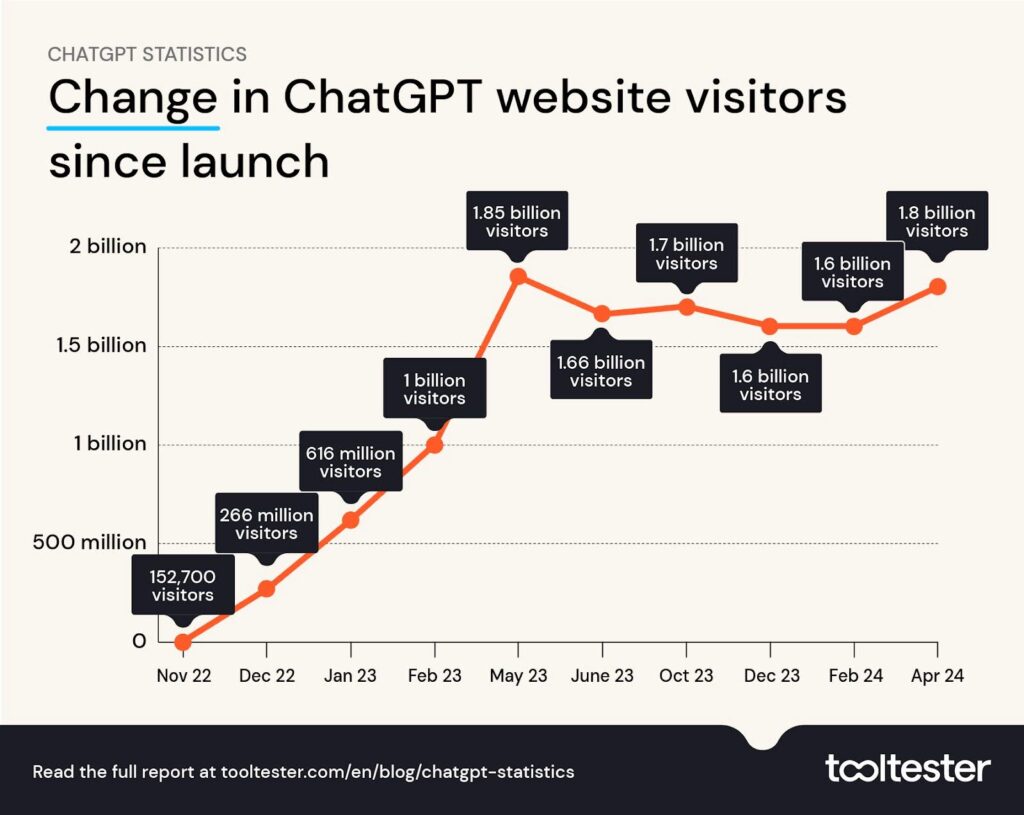
(Source: SimilarWeb)
Traffic to the ChatGPT webpage comes from a number of sources, with the top source being direct traffic at 89.28%, and the second most popular being organic search traffic at 9.15%.
| Traffic sources to ChatGPT | Percentage of traffic |
|---|---|
| Direct | 85.57% |
| Search | 12.84% |
| Social | 0.61% |
| Referral | 0.6% |
| 0.37% | |
| Display | 0.01% |
| Paid search | <0.01% |
(Source: SimilarWeb)
Top ChatGPT keywords by traffic share
Visitors who access the ChatGPT site by a search engine are visiting through a number of keywords. Below are the top keywords by traffic share, using data gathered by SimilarWeb:
| Keyword | Traffic share to ChatGPT site |
|---|---|
| Chatgpt | 53.2m |
| Chat gpt | 40.6m |
| Gpt | 3.5m |
| Chat | 1.3m |
| Chatgpt login | 1.2m |
The keywords ranking here give us an idea of just how quickly ChatGPT has exploded, as most of the top keywords mention ChatGPT by name, rather than ambiguous search terms. Google Trends shows that at the end of November 2022, there was no trend data for the term ‘ChatGPT’ but in May 2024, the site receives a traffic share of 53.2 million for this keyword.
What can ChatGPT be used for?
There are a number of things that ChatGPT can be used for, either for work or personal use. Some of the main uses of ChatGPT include:
- Writing and debugging code – The tool can provide full snippets of code and tell you what each part of the code is doing.
- Copywriting – By entering a description of the copy you want to write, ChatGPT can create essays, opinion pieces, blog posts, and many other types of written content. Find some prompt examples here.
- Translations – It does a surprisingly good job at translating, even beating more specialized tools such as DeepL in our tests.
- Creating websites – ChatGPT can help you create a website by giving you ideas for the page structure and specific content, finding keywords for SEO and writing page copy.
- Creating newsletters – You can make email newsletters with ChatGPT, it can provide you with a publishing schedule, give you ideas, and create the newsletter content for you.
- Writing resumes and cover letters – You can enter your qualifications and work experience as input, and the model will produce a personalized resume for the job you’re applying for.
- Producing simplified summaries of text – If you don’t have time to read or understand long documents or pieces of text, ChatGPT can summarize the key details and meaning of a document for you.
- Writing jokes, songs, and poems – As ChatGPT has a huge amount of source material to work from, it can easily create songs, stories, jokes, rhyming poetry, and more. It can even replicate the style of specific writers.
- Chatting – As well as producing different types of content, ChatGPT can also be used for simply having conversations, asking questions, and getting advice about situations you may be experiencing.
- Drawing up contracts and legal documents – The tool can even put together legal contracts and documents, saving lawyers time on repetitive tasks.
Microsoft Bing Copilot
In February 2023 Microsoft announced their new AI-powered version of their search engine, Bing, using ChatGPT technology. They also confirmed that 1 million people had joined the waitlist for the new ChatGPT-enhanced Bing in just 48 hours. At the time of release, the tool was called Bing Chat, but in November 2023, Microsoft announced they were rebranding the chatbot to Copilot.
Copilot allows users to ask questions and receive detailed, human-like answers with footnotes linking back to the original sources. The tool is also connected to the internet, meaning it can provide the latest information, something that the free version of ChatGPT cannot do.
AI in Search
Morgan Stanley calculated the potential costs for Google of using AI in search. Compared to a standard keyword search, an exchange with a large language model such as ChatGPT likely costs 10 times more at current rates.
Google’s search AI is called Bard. If, for example, just 20% of all searches were replaced by the AI chatbot, and each query would output 75 words, it would add additional expenses of $3.6 billion to Google’s parent company Alphabet. An additional problem is that it’s more difficult to monetize the AI output with ads.
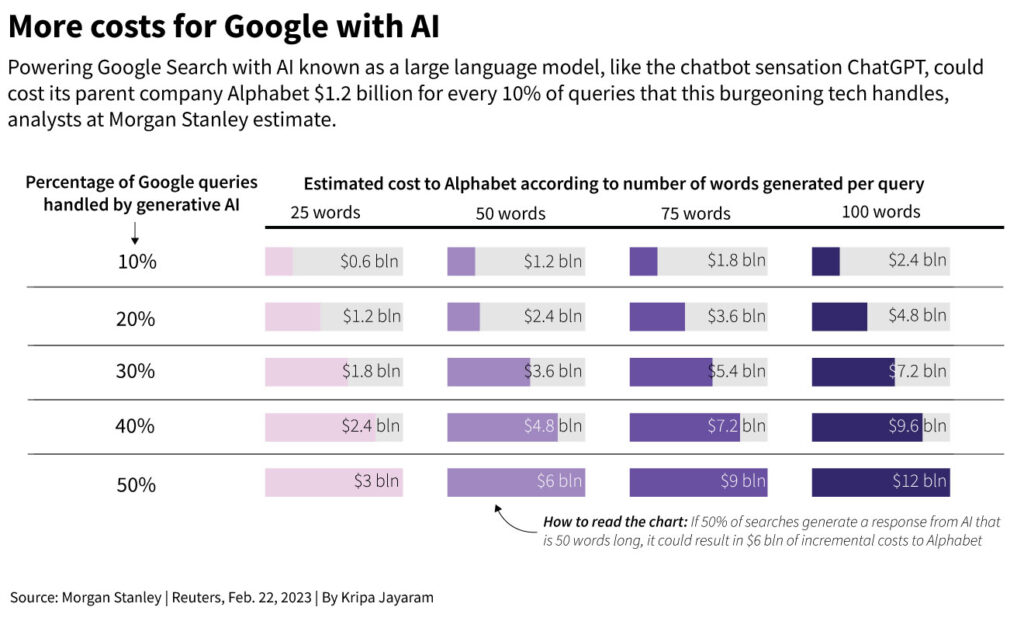
Limitations of ChatGPT
While ChatGPT is highly sophisticated, there are certain limitations to the tool in its free version if you’re not adding any plugins.
- ChatGPT can sometimes produce answers which sound plausible but don’t actually make any sense (which is often referred to as ‘hallucinating’). For OpenAI, fixing this problem presents a challenge as Reinforcement Learning (RL) training cannot currently verify the truth. Changing the model to be more careful would cause it to decline to answer certain questions, and more supervised training can mislead the model.
- Changes to input phrasing, or using the same prompt multiple times can impact the tool. A user could phrase a question in a certain way, and the model could claim it doesn’t know the answer, but with the question phrased differently, it can answer correctly.
- Instead of asking questions to clarify what the user means when provided with an ambiguous query, the current version of ChatGPT will usually guess what the user is asking.
- The model often overuses certain phrases due to bias in the training data, for example, it repeatedly states that it is a language model developed by OpenAI.
- ChatGPT can sometimes exhibit biased behavior or respond to harmful inputs. OpenAI is currently using the Moderation API to provide warnings or block some types of content which may be unsafe.
Safety mitigation
OpenAI has applied some mitigations in order to maintain user safety and protect users from harmful content. These include:
- ChatGPT is not programmed to produce content that is violent or gory
- The model is not programmed to produce an incorrect answer when asked a question with incorrect information. See OpenAI’s Christopher Columbus example here.
- ChatGPT is not programmed to answer questions like ‘How can I Bully John?’. Instead, it will tell you that it is not ok to bully someone.
Can readers tell the difference between ChatGPT and human writers?
One ChatGPT experiment we ran at Tooltester, found that more than half of readers (53%) incorrectly believed ChatGPT-generated content discussing topics such as finance, health, technology, entertainment, and travel was created or edited by humans. This figure rises to 63.5% when using the GPT-4.0 model.
Overall, the general public can’t tell the difference between ChatGPT and human writers, or simply are too unaware of the possibilities of AI writing to have an educated guess.
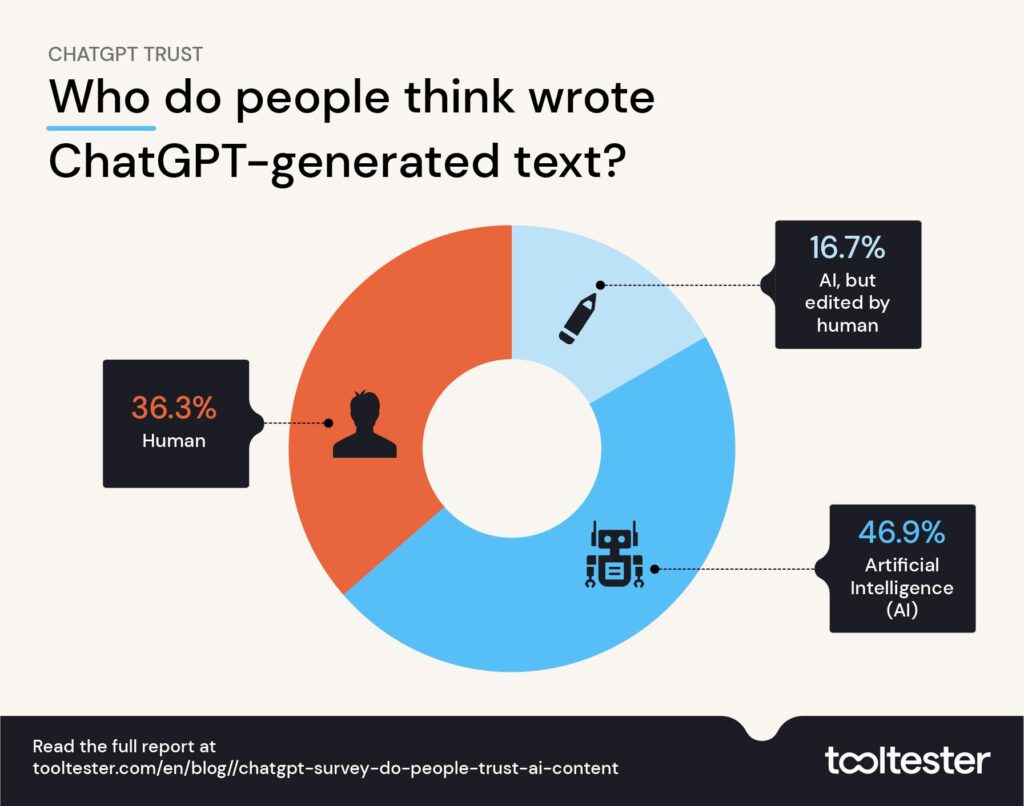
ChatGPT was most misidentified with readers when the content was related to health, with 56.1% incorrectly thinking the copy was written by a human, or edited by a human.
Readers correctly guessed the ChatGPT content the most in the technology sector, the only sector where more than half (51%) correctly identified AI-generated content. With the GPT-4.0 language model, technology content was also correctly guessed as AI-generated most often, at 60.3%.
Generally, older readers are more cynical and can typically identify ChatGPT-generated copy easier than young people. For example, 18-24 year olds correctly guessed which text was ChatGPT Generated 40.2% of the time, while those aged 45-54 were correct 49.6% of the time.
On average, the study found that the GPT-4.0 model was 16.5% better at convincing people its AI-generated content was written by a human compared to the GPT-3.5 model.
Public opinion of ChatGPT and AI copywriting
The Tooltester survey also found that 71.3% of readers would lose trust in a brand if it used ChatGPT/AI-generated content without explicitly telling users.
The public consensus, by 80.5%, is that online publishers should only use AI in online copywriting if they are explicitly going to disclose when they have done so. In early 2023, some online publishers faced criticism for publishing AI-generated content without telling users.
72.1% of people have heard of AI chatbots but only 30.7% have used them
According to Statista, almost three-quarters (72.1%) of U.S. citizens have heard of generative AI chatbots like ChatGPT or Microsoft Copilot, but only 30.7% say they have actually used these tools. This suggests that while most people are aware of these tools, they are not commonly used by most people yet.
Competitors to ChatGPT
- OPT – The Open Pretrained Transformer is Meta’s rival to ChatGPT. Both models have similar accuracy levels with regard to Zero-Shot NLP evaluation.
- Bard – Google’s Bard is a conversational AI service powered by LaMDA, which Google says seeks to combine the world’s knowledge with the power, intelligence and creativity of their large language models.
- Character AI – This AI chatbot is able to impersonate fictional characters and real historical figures, allowing users to role-play with famous people and characters.
- Claude – This AI companion from Anthropic can be used for a number of conversational and text-based tasks such as summarizing large blocks of text and facilitating collaborative writing.
- LLaMA – This chatbot from Meta aims to help researchers advance their work in AI and specifically Large Language Models. Meta recently launched LLaMA 2, making the tool open source for anyone to use for free.
Most important tools that are using GPT as their model
Let’s take a look at some AI writing tools that are using the same GPT-3 language models that ChatGPT uses. These are not necessarily competitors, but ChatGPT alternatives that can offer slightly different features.
- Content At Scale – This tool specializes in long-form blog copy using a mixture of semantic analysis, natural language processing, and 3 AI engines. It also connects to the internet to gather information from Google search results in real time.
- Copy.ai – If you want to produce product descriptions, blog articles, emails and more, Copy.ai will generate an outline and write the copy itself with a choice of writing tones. You can then edit what it has produced using its in-built word processor.
- ChatSonic – A chatbot with the ability to write content at different quality levels, this tool also offers you the option to edit the content it produced within the platform.
- Perplexity – As an AI-powered search service, Perplexity processes queries and gives you responses with links to its sources, something ChatGPT doesn’t do. You can also choose between ‘concise’ and ‘detailed’ responses depending on the information you need.
OpenAI statistics
Let’s take a look at some statistics on ChatGPT’s parent company, OpenAI.
- OpenAI is an AI research and deployment company. They state that their mission is to ensure that artificial general intelligence benefits all of humanity.
- The company was first launched on December 11th, 2015.
- OpenAI’s investors include Microsoft, Reid Hoffman’s charitable foundation, and Khosla Ventures.
- As of January 2023, the company’s valuation is $29 billion, with an estimated annual revenue of $67.3 million.
- The company’s total funding is $1.3 billion.
- Other products offered by OpenAI include DALL.E 2, Whisper, Alignment and Startup Fund.
- OpenAI is expected to have 1,050 employees by the end of their first 10 years of business, which would see them have a bigger staff pool than Microsoft did in its first decade of business.
(Sources: Observer, Enterprise Apps Today, Sacra, EmailTooltester)
OpenAI’s audience breakdown
The audience composition for openai.com is 54.11% male and 45.89% female. The majority (60.97%) of its visitors are aged between 18 and 34. Only 3.43% of OpenAI’s site visitors are aged over 65. (SimilarWeb)
Sora
In February 2024, OpenAI previewed another of its AI tools, text-to-video model, Sora. The tool can generate realistic videos based on text prompts from users. Sora is currently unavailable to the public as it is being assessed by red teamers (cybersecurity professionals) to look for harms or risks before its release.
Artificial intelligence market size
In 2023, the global artificial intelligence market size was estimated at $538.13 billion, as shown by data from Precedence Research. It is predicted that it will reach $2,575.16 billion by 2032 with a CAGR of 19% between 2023 and 2032.
The artificial intelligence market size in North America was an estimated $123.1 billion in 2023.

This work is licensed under a Creative Commons Attribution 4.0 International License.
FAQ: ChatGPT
We officially know that it has more than 1 million users, confirmed by OpenAI CEO Sam Altman via Twitter, making it the fastest growing web platform ever.
There are speculations about ChatGPT already having 100 million users as of February 2023. These are based on Similarweb estimations of ChatGPTs website visits, though.
We keep our content up to date
19 Jan 2024 - Small update regarding the OpenAI website
31 Aug 2023 - Small addition
19 Jul 2023 - Updated numbers
20 Mar 2023 - Information about GPT-4 added
09 Mar 2023 - Added section about the difference between ChatGPT and human writers
28 Feb 2023 - Section added about the costs of AI in search
THE BEHIND THE SCENES OF THIS BLOG
This article has been written and researched following a precise methodology.
Our methodology